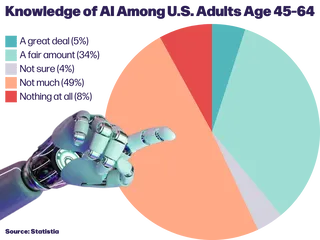
Hot Take: Don’t Use AI In Marketing (Yet)
 Artificial intelligence (AI) is making our lives significantly better in many ways, from detecting diseases to saving the bees. Clearly, it can be used for good, so I want to start by sharing I’m not a total AI hater. I only hate some parts about AI—one of which is its impact on art and stock photography.
Artificial intelligence (AI) is making our lives significantly better in many ways, from detecting diseases to saving the bees. Clearly, it can be used for good, so I want to start by sharing I’m not a total AI hater. I only hate some parts about AI—one of which is its impact on art and stock photography.
Even though AI art dates back to the '70s, it's experienced a massive surge since January 2021 when DALL-E launched its text-to-image generator. Today, there are dozens of AI image generators in the game, including the newest player on the scene, DeepSeek, an AI program out of China that’s apparently so good it’s causing an “extinction-level event” in American venture capital.

The public may use these generators to create fun content for social media (case in point: Nosferatu in RuPaul’s Drag Race) but marketers and businesses have become increasingly reliant on them to keep content creation convenient. And, for some time, it did. Now? Alleged AI cannibalism, a widening generational gap and a lack of good regulation have made it harder than before for AI to source good images and graphics.
The Problems AI Has Caused
The speedy rise of artificial intelligence has caused—to put it lightly—significant challenges. From using up all of our water to uprooting entire professions to inflaming the misinformation epidemic, AI has had quite the villain origin story. Destroying the planet is obviously the worst outcome, but not the only bad outcome. AI has also had a negative impact on marketing. Here are a few.
A Widening Generation Gap
Digital native generations like Gen Alpha, Gen Z and Millennials are relatively adept at spotting what is and isn’t AI. It turns out that not only do they recognize AI, but also that they don’t like it. These demographics generally believe AI is cheap, commercial and inauthentic—a death sentence for brands looking to establish meaningful relationships with consumers. In fact, when Coca-Cola released an AI-generated Christmas commercial in 2024, the backlash was so severe that the beverage company had to provide a statement defending its actions. Not a cute look.
So, if AI isn’t accepted by Gen Alpha, Gen Z, and Millennials, what about the audiences over 45 who receive your marketing messages?

In a recent survey, three-fourths of adults over 50 don't trust AI info, but over half say they know "not much" about AI. Without knowing what is and isn't AI, how are they supposed to know what to distrust? When AI is so good that it looks like real information, Americans’ distrust doesn’t mean much. The one thing that remains across the generations, however, is that younger audiences can tell when your content is inauthentic, and older audiences are largely predisposed to disbelieving your content anyway.
A Perplexing New Era of IP
When you input a prompt, AI algorithms search a dataset of images from the Internet to use as inspiration to complete your request. Except it can’t create something from nothing (yet) so it’s using bits and pieces of what humans have already made to generate something new. Artists have done this forever. But artists create derivative works with their own talents, perspectives and styles. When asked to create, rather than regurgitate, AI cannot.
AI image generators rely on what already exists, creating intellectual property (IP) issues and challenging traditional ideas about authorship and ownership. Government guidance has not even remotely kept up with the rapid pace of AI development, so we’re in the wild, wild West here, which makes a lot of marketers very uneasy and makes it a little scary to rely on AI images. The businesses that, in response to hard times, have moved from human designers to AI designers may be in for tough times if IP laws catch up and aren’t in their favor.
A Lack of Faith in Stock Sites
There is a flood of AI-generated images online. Not only are seniors having a hard time figuring out what's AI and what's not, stock sites are too, and graphic designers and marketers say it's making it even more tedious to find usable photography. Original photos and videos are the gold standard, but it can be a costly endeavor, leaving many companies and agencies to rely exclusively on stock content. What do you do when you can’t trust your sources?
The age-old stock vs. original photography question has more or less had a relatively clear answer—use stock only when necessary—until now that AI has entered the chat. Many businesses are increasingly being put in the position to choose between a graphic designer that they can’t afford and a stock site that they can’t trust.
A Lack of Accuracy
There's a growing audience of people online who are concerned about ‘AI cannibalism’, or AI using other AI as inspiration, making everything worse and even more unbelievable.
One heinous example is AI image generators creating images of Nazi-era German soldiers as people of color. All AI image generator models claim to use datasets of vetted images from before AI art became prevalent, but even then, AI has struggled with depicting historical, anatomical and societal accuracy.
The inaccuracy is so prevalent that it’s caused lasting distrust. Even when marketers aren’t using AI-generated images, their audiences are assuming (or accusing) that they are. The public already has “an implicit negative bias toward AI art,” and many people are raring and ready to go on the offensive.
What Marketers and Brands Should Use Instead of AI
You can’t wipe AI images off the face of the earth, or even convince Silicon Valley to stop investing in artificial intelligence, but there are things you can do to ease the pain AI has inflicted on marketing.
Get Better at Spotting AI Images
Learn how to differentiate AI images from original images—and help others do the same. And, if you can, voice your discontent with stock photography and videography providers so that they can improve their algorithms and/or better educate their audience. Until then, there are a few ways to determine with relatively decent accuracy if an image was made by AI:
- Eye the anatomy. It's easy to spot an extra limb or misplaced facial features, but it's harder to see a backward thumb or mysteriously missing belly button.
- Ask if it’s "too good to be true." If a person's skin has a sheen or is too perfect, or if the subject just seems like it can't be real, you should be suspicious.
- Think about the functionality. It all may seem legit, but if the kid in the background is pushing on a "pull only" door or a cat is jumping 12 feet into the air, you've just found yourself an AI image.
- Point out "sociocultural implausibilities." If you don't remember the Taylor Swift AI debacle in 2024 in which someone created an AI image of the pop star endorsing Donald Trump for president, then good for you. But it stands as a perfect example of "sociocultural implausibility." In the photo, Taylor is anatomically correct, appears natural and functions as a human would, but as any Swiftie would tell you, there's no way she'd be such an “Anti-Hero.”
Make Original AI and Use Others’ Original Photos
Rather than rely on stock sites to provide AI, since they’re not doing so hot at labeling what is and isn’t artificial, use AI image generators to make your own. Filter out AI images on stock sites, and use only original, human-made stock photography. With so many AI image generators out there, if you’re going to use AI, you might as well whip up a photo from scratch.
You don’t have to use stock sites, either. The best thing you can do is hire a photographer or graphic designer. The next-best thing you can do is solicit user-generated content, run a photography contest, or learn how to take better original photos for yourself.
Our favorite option, though? Hire a super-cool, award-winning, woman-owned marketing agency that specializes in forming true relationships through bespoke marketing strategies
AI tools aren’t going anywhere, but as they stand, they aren’t creating the returns marketers and brands want. Brands that want personal, authentic relationships with audiences will have to give those audiences personal, authentic content.